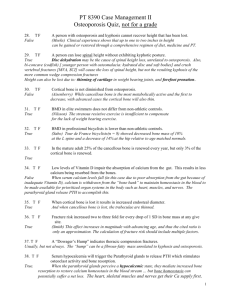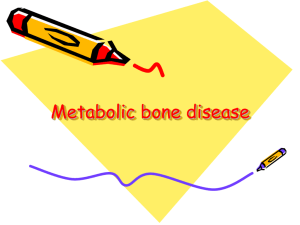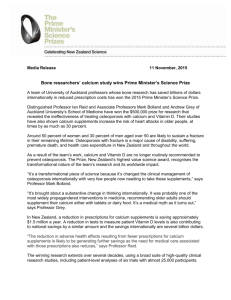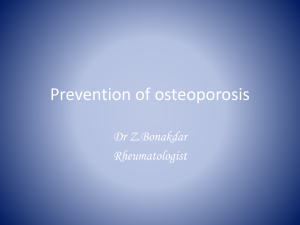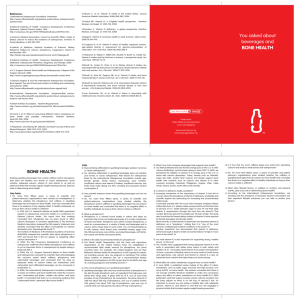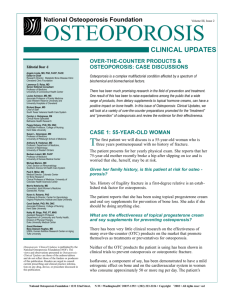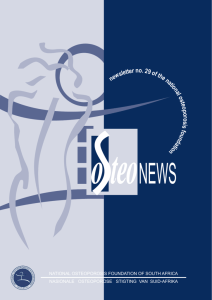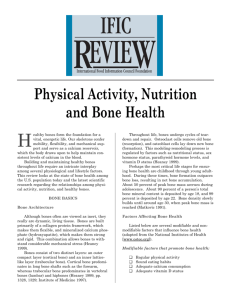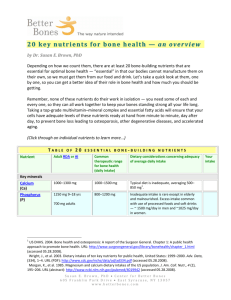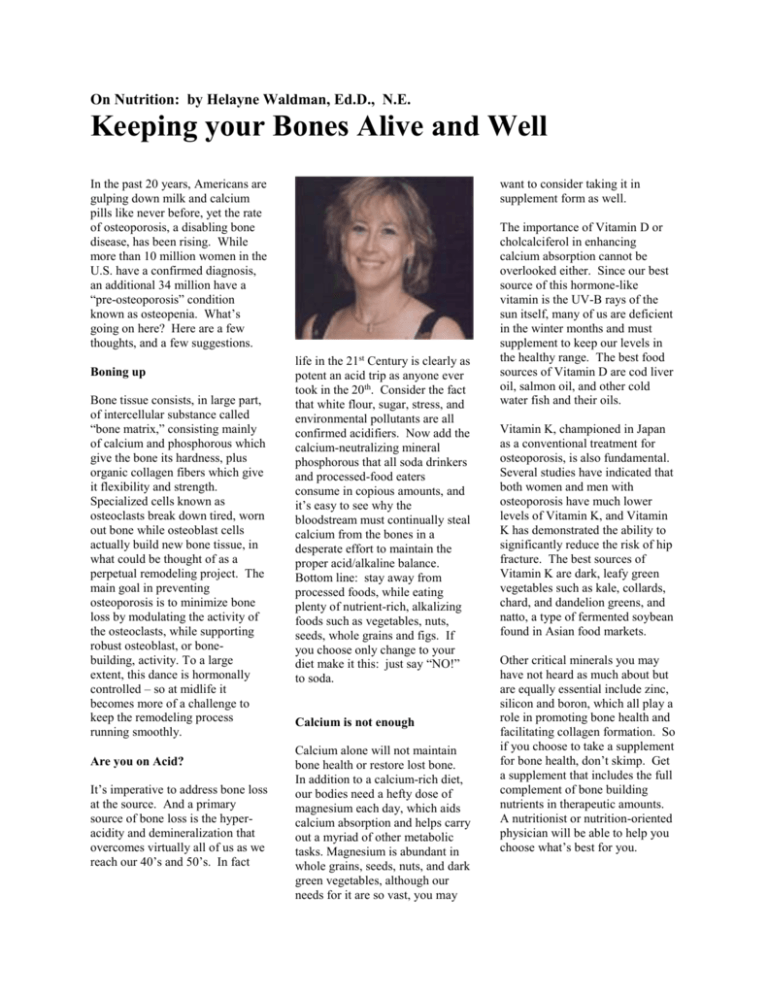
On Nutrition: by Helayne Waldman, Ed.D., N.E.
Keeping your Bones Alive and Well
In the past 20 years, Americans are
gulping down milk and calcium
pills like never before, yet the rate
of osteoporosis, a disabling bone
disease, has been rising. While
more than 10 million women in the
U.S. have a confirmed diagnosis,
an additional 34 million have a
“pre-osteoporosis” condition
known as osteopenia. What’s
going on here? Here are a few
thoughts, and a few suggestions.
Boning up
Bone tissue consists, in large part,
of intercellular substance called
“bone matrix,” consisting mainly
of calcium and phosphorous which
give the bone its hardness, plus
organic collagen fibers which give
it flexibility and strength.
Specialized cells known as
osteoclasts break down tired, worn
out bone while osteoblast cells
actually build new bone tissue, in
what could be thought of as a
perpetual remodeling project. The
main goal in preventing
osteoporosis is to minimize bone
loss by modulating the activity of
the osteoclasts, while supporting
robust osteoblast, or bonebuilding, activity. To a large
extent, this dance is hormonally
controlled – so at midlife it
becomes more of a challenge to
keep the remodeling process
running smoothly.
Are you on Acid?
It’s imperative to address bone loss
at the source. And a primary
source of bone loss is the hyperacidity and demineralization that
overcomes virtually all of us as we
reach our 40’s and 50’s. In fact
want to consider taking it in
supplement form as well.
life in the 21st Century is clearly as
potent an acid trip as anyone ever
took in the 20th. Consider the fact
that white flour, sugar, stress, and
environmental pollutants are all
confirmed acidifiers. Now add the
calcium-neutralizing mineral
phosphorous that all soda drinkers
and processed-food eaters
consume in copious amounts, and
it’s easy to see why the
bloodstream must continually steal
calcium from the bones in a
desperate effort to maintain the
proper acid/alkaline balance.
Bottom line: stay away from
processed foods, while eating
plenty of nutrient-rich, alkalizing
foods such as vegetables, nuts,
seeds, whole grains and figs. If
you choose only change to your
diet make it this: just say “NO!”
to soda.
Calcium is not enough
Calcium alone will not maintain
bone health or restore lost bone.
In addition to a calcium-rich diet,
our bodies need a hefty dose of
magnesium each day, which aids
calcium absorption and helps carry
out a myriad of other metabolic
tasks. Magnesium is abundant in
whole grains, seeds, nuts, and dark
green vegetables, although our
needs for it are so vast, you may
The importance of Vitamin D or
cholcalciferol in enhancing
calcium absorption cannot be
overlooked either. Since our best
source of this hormone-like
vitamin is the UV-B rays of the
sun itself, many of us are deficient
in the winter months and must
supplement to keep our levels in
the healthy range. The best food
sources of Vitamin D are cod liver
oil, salmon oil, and other cold
water fish and their oils.
Vitamin K, championed in Japan
as a conventional treatment for
osteoporosis, is also fundamental.
Several studies have indicated that
both women and men with
osteoporosis have much lower
levels of Vitamin K, and Vitamin
K has demonstrated the ability to
significantly reduce the risk of hip
fracture. The best sources of
Vitamin K are dark, leafy green
vegetables such as kale, collards,
chard, and dandelion greens, and
natto, a type of fermented soybean
found in Asian food markets.
Other critical minerals you may
have not heard as much about but
are equally essential include zinc,
silicon and boron, which all play a
role in promoting bone health and
facilitating collagen formation. So
if you choose to take a supplement
for bone health, don’t skimp. Get
a supplement that includes the full
complement of bone building
nutrients in therapeutic amounts.
A nutritionist or nutrition-oriented
physician will be able to help you
choose what’s best for you.
You are what you assimilate
The purest, most potent of
nutrients won’t do you any good if
you’re not able to absorb them.
Certain forms of calcium have a
reputation for being highly
absorbable, while other forms will
just pass on through to the other
side. Dr. Susan Brown, director of
the Osteoporosis Education Project
recommends calcium citrate, and
warns against calcium carbonate,
dolomite, bone meal and oyster
shell, which are prone to heavy
metal contamination.
Since calcium, vitamin D, and
vitamin K all need fat to facilitate
their absorption, it’s essential to
consume healthy sources of fat
along with your bone building
nutrients. Think nuts, seeds, olive
oil, avocado, yogurt and wild
salmon or halibut. Skim milk (0%
fat) on its own is not going to
provide you with highly
absorbable, bone-building
nutrients so parents take note --children should never drink skim
milk alone as their main source of
calcium.
One more thing: as we age, most
of us produce less and less
hydrochloric acid (HCl), which
helps to break down calcium in the
stomach. Look for a supplement
that contains betaine hydrochloride
in it, or consider taking digestive
enzymes on a regular basis to
ensure assimilation.
Use it or lose it
Exercise rounds out the picture
here in creating a hedge against
osteoporosis. “I think exercise is
the single most important thing
that people can do for themselves,
and specifically, loadbearing
exercise,” says Dr. Gregory
Mundy, professor of Bone and
Mineral Metabolism at the
University of Texas.
The key, of course, is to listen to
both Dr. Mundy and your
nutritionist – exercising good
choices both at the table and at the
gym.
____________________________
Helayne Waldman, Ed.D , N.E.,. is
a health and nutrition educator, a
writer, and an Adjunct Professor
in the Dept. of Holistic Health
Studies at JFK University. She
can be reached at
hwaldman@turning-thetables.com, or on the web at
www.turning-the-tables.com
©2005-2006 Helayne Waldman, Ed.D., N.E.. All rights reserved.




